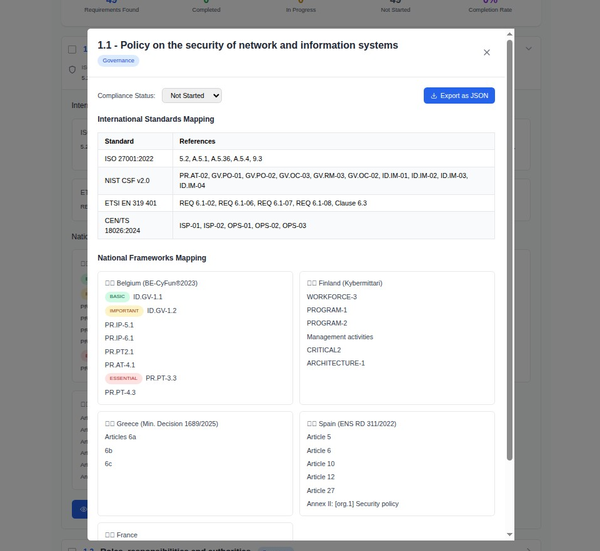Understanding the Growing Disparity in Cyber Resilience

Key Takeaway
The key takeaway from the web page content is that there is a growing disparity in cyber resilience between organizations, with some becoming cyber resilient while others struggle to keep up. This divide is exacerbated by factors such as the rising cost of cyber services and the rapid adoption of cutting-edge technology by large organizations.
https://www3.weforum.org/docs/WEF_Global_Cybersecurity_Outlook_2024.pdf
Summary
- The Global Cybersecurity Outlook 2024 report highlights a significant and growing disparity in cyber resilience among organizations.
- Organizations maintaining minimum viable cyber resilience are decreasing, down 31% since 2022, leading to a widening gap between cyber-resilient and struggling organizations.
- The smallest organizations are more likely to lack cyber resilience, while the largest organizations are more confident in their cyber resilience.
- The cyber skills and talent shortage is widening, with half of the smallest organizations lacking the skills they need for cyber resilience.
- Geopolitical tensions continue to influence cybersecurity strategies, with 70% of leaders stating that geopolitics has influenced their organization's cybersecurity strategy.
- Emerging technologies like generative AI pose new cybersecurity challenges, including deepfakes and misinformation.
- The intersection of cyber and election security is a significant concern, with AI-driven disinformation campaigns and targeted advertising being used to influence elections.
- The rapid uptake of emerging technologies has outpaced the ability to implement safety and security measures, emphasizing the need for fundamental security and resilience.
Overall, the report underscores the importance of addressing the growing cyber resilience gap, the impact of emerging technologies, and the influence of geopolitics on cybersecurity strategies. It calls for collaborative efforts to enhance cyber resilience and protect against evolving cyber threats.
Chapter 1. Introduction
1.1. Understanding the Growing Disparity in Cyber Resilience
- Brief overview of the Global Cybersecurity Outlook 2024 report.
- Importance of cyber resilience in today's digital landscape.
1.2. Factors Exacerbating the Cyber Resilience Divide
- Highlighting the key factors contributing to the growing gap.
- Introduction to the rising cost of cyber services and technology adoption.
Chapter 2. The State of Cyber Inequity
2.1. Decline in Minimum Cyber Resilience
- Statistics on the decrease in organizations maintaining minimum cyber resilience.
- Impact of this decline on the overall cyber landscape.
2.2. Small vs. Large Organizations
- Examining the disparity in cyber resilience between small and large organizations.
- Insights into why smaller organizations struggle to keep up.
2.3. The Skills and Talent Shortage
- Analysis of the wideningcyber skills and talent gap.
- Implications of the shortage on organizations of all sizes.
Chapter 3. Geopolitical Influences on Cybersecurity
3.1. Geopolitics and Cybersecurity Strategies
- How geopolitics has a significant influence on organizations' cybersecurity strategies.
- Examples of geopolitical events impacting cybersecurity.
3.2. Adapting to Rapidly Shifting Landscapes
- Strategies employed by organizations to adapt to the rapidly changing geopolitical landscape.
- The role of threat intelligence reports and incident response plans.
Chapter 4. Emerging Technologies and Cybersecurity
4.1. The Rise of Generative AI
- Understanding the implications of generative AI on cybersecurity.
- Specific threats like deepfakes and misinformation.
4.2. Cyber Threats in Elections
- Discussing the intersection of cyber threats and election security.
- The role of AI-driven disinformation campaigns in elections.
4.3. The Challenge of Implementing Safety Measures
- Exploring the challenges organizations face in implementing safety and security measures for emerging technologies.
- The need for fundamental security and resilience.
Chapter 5. Collaborative Efforts for Cyber Resilience
5.1. Addressing the Growing Cyber Resilience Gap
- The importance of collaborative efforts to bridge the cyber resilience gap.
- The role of public-private cooperation in cybersecurity.
5.2. Protecting Against Evolving Cyber Threats
- Strategies for organizations to protect themselves against evolving cyber threats.
- The need for proactive cybersecurity measures.
Chapter 6. Conclusion
6.1. Key Takeaways
- Summarizing the main points of the article.
- Reinforcing the significance of addressing cyber resilience challenges.
6.2. Call to Action
- Encouraging organizations to prioritize cybersecurity and collaborate for a more secure digital future.
- The role of leadership in fostering a culture of cyber resilience.
Understanding the Growing Disparity in Cyber Resilience
In the rapidly evolving digital landscape of 2024, the significance of cyber resilience cannot be overstated. The Global Cybersecurity Outlook 2024 report has shed light on a concerning trend - a growing disparity in cyber resilience among organizations. This article delves into the key factors contributing to this divide and examines the implications for businesses of all sizes.
Factors Exacerbating the Cyber Resilience Divide
The Decrease in Minimum Cyber Resilience
One alarming trend highlighted in the report is the decline in organizations maintaining the minimum viable level of cyber resilience. Since 2022, there has been a notable 31% decrease in the number of organizations meeting this threshold. This decline paints a worrying picture of the overall cyber landscape.
Small vs. Large Organizations
A striking observation is the significant gap in cyber resilience between small and large organizations. While larger enterprises often boast robust cybersecurity measures, smaller businesses struggle to keep up. This discrepancy can be attributed to various factors, including budget constraints and resource limitations.
The Skills and Talent Shortage
Another critical aspect contributing to the cyber resilience gap is the widening skills and talent shortage. Across the board, organizations are facing challenges in finding professionals with the necessary expertise to bolster their cybersecurity efforts. This shortage is particularly pronounced among smaller organizations, with half of them lacking the skills required for cyber resilience.
Geopolitical Influences on Cybersecurity
Geopolitics and Cybersecurity Strategies
Geopolitical factors play a significant role in shaping organizations' cybersecurity strategies. The report indicates that 70% of leaders acknowledge the influence of geopolitics on their cybersecurity approach. Events on the global stage can directly impact the threat landscape and necessitate adjustments in cybersecurity measures.
Adapting to Rapidly Shifting Landscapes
To navigate the swiftly changing geopolitical landscape, organizations employ strategies like monitoring threat intelligence reports and implementing incident response plans. Staying informed and agile in response to geopolitical developments is crucial for maintaining cyber resilience.
Emerging Technologies and Cybersecurity
The Rise of Generative AI
Generative AI is on the rise and brings both promise and peril to cybersecurity. Understanding the implications of this technology is essential. It can be harnessed for innovative security solutions, but it also introduces threats like deepfakes and misinformation, which can undermine trust and security.
Cyber Threats in Elections
The intersection of cyber threats and election security is a significant concern. AI-driven disinformation campaigns and targeted advertising are being employed to influence elections. Safeguarding the integrity of electoral processes is paramount in an era of evolving cyber threats.
The Challenge of Implementing Safety Measures
The rapid adoption of emerging technologies has often outpaced the ability to implement safety and security measures effectively. This challenge underscores the need for fundamental security and resilience in the face of rapidly evolving technological landscapes.
Collaborative Efforts for Cyber Resilience
Addressing the Growing Cyber Resilience Gap
In light of these challenges, collaborative efforts are key to bridging the cyber resilience gap. Public-private cooperation is essential, as no single entity can combat cyber threats in isolation. Collective intelligence and resources can significantly enhance cybersecurity capabilities.
Protecting Against Evolving Cyber Threats
Organizations must adopt proactive cybersecurity measures to protect themselves against evolving threats. Relying solely on traditional approaches is no longer sufficient. A proactive stance involves continuous monitoring, threat hunting, and rapid response to mitigate potential risks.
Conclusion
Key Takeaways
The Global Cybersecurity Outlook 2024 report underscores the critical importance of addressing the growing cyber resilience gap. Key takeaways include the decline in minimum cyber resilience, the disparity between small and large organizations, and the skills and talent shortage. Geopolitics and emerging technologies further complicate the cybersecurity landscape.
Call to Action
In conclusion, organizations must prioritize cybersecurity and collaborate to create a more secure digital future. Leadership plays a pivotal role in fostering a culture of cyber resilience, where staying ahead of evolving threats is not just a priority but a collective responsibility. The challenges are significant, but with concerted efforts, the divide in cyber resilience can be narrowed, and organizations can thrive in an increasingly digital world.





